Comprehensive Analysis of Audit and Assurance: Procedures & Risk
VerifiedAdded on 2023/06/07
|8
|1260
|191
Report
AI Summary
This report provides a detailed overview of audit and assurance procedures, differentiating between internal and external audit functions, and outlining various methods for obtaining audit evidence. It discusses analytical procedures, inquiry, inspection, observation, and recalculation, highlighting their suitability and limitations in the context of financial statement analysis. Furthermore, the report addresses risk assessment, detailing responses to specific risks such as those related to purchase orders, refurbishing expenses, bank loans, and online bookings. It also contrasts test of controls with substantive procedures, and identifies three key procedures for reviewing overall financial statements, including analytical procedures, substantive procedures, and inquiry. The document serves as a comprehensive resource for understanding the core principles and practices of auditing and assurance.
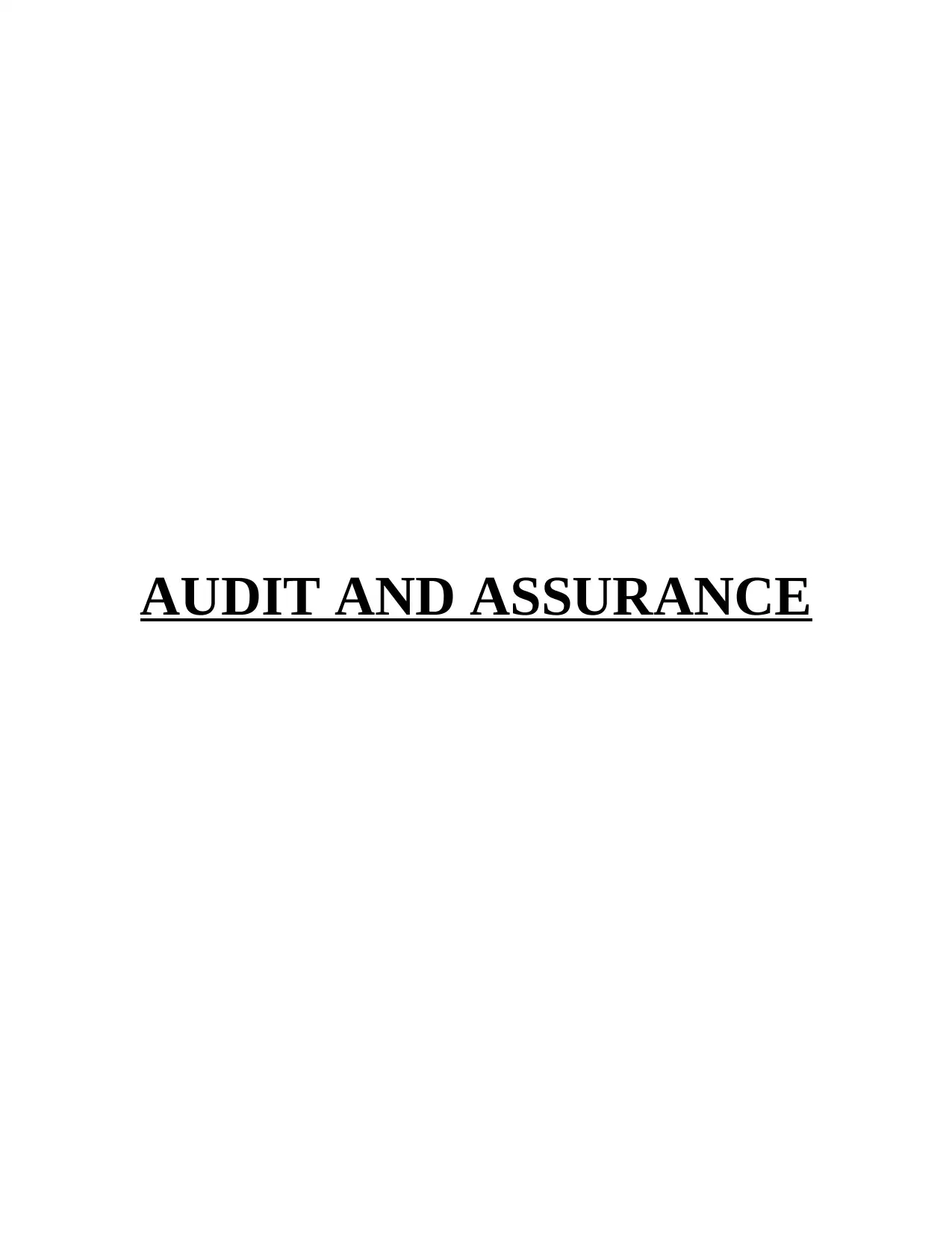
AUDIT AND ASSURANCE
Paraphrase This Document
Need a fresh take? Get an instant paraphrase of this document with our AI Paraphraser
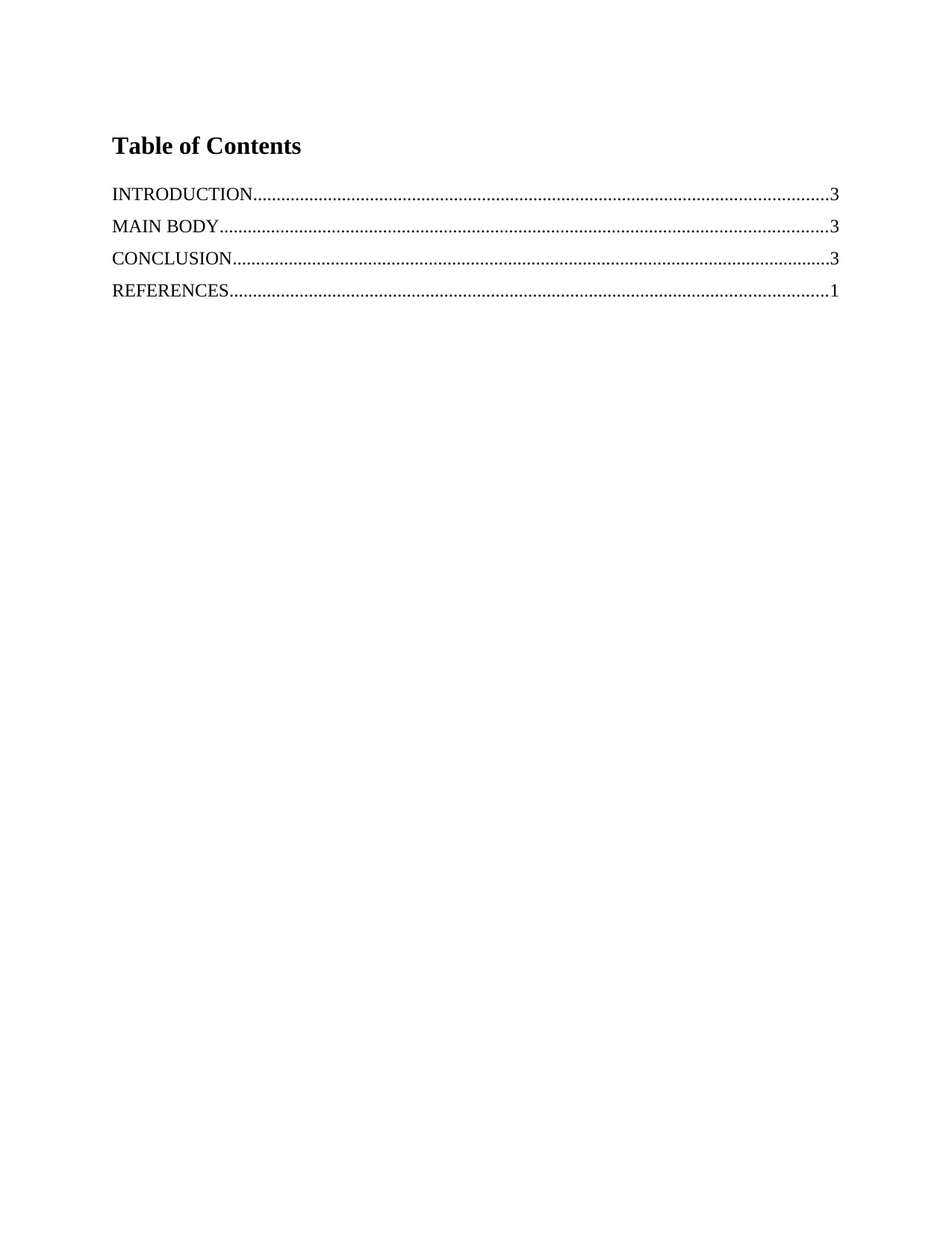
Table of Contents
INTRODUCTION...........................................................................................................................3
MAIN BODY..................................................................................................................................3
CONCLUSION................................................................................................................................3
REFERENCES................................................................................................................................1
INTRODUCTION...........................................................................................................................3
MAIN BODY..................................................................................................................................3
CONCLUSION................................................................................................................................3
REFERENCES................................................................................................................................1
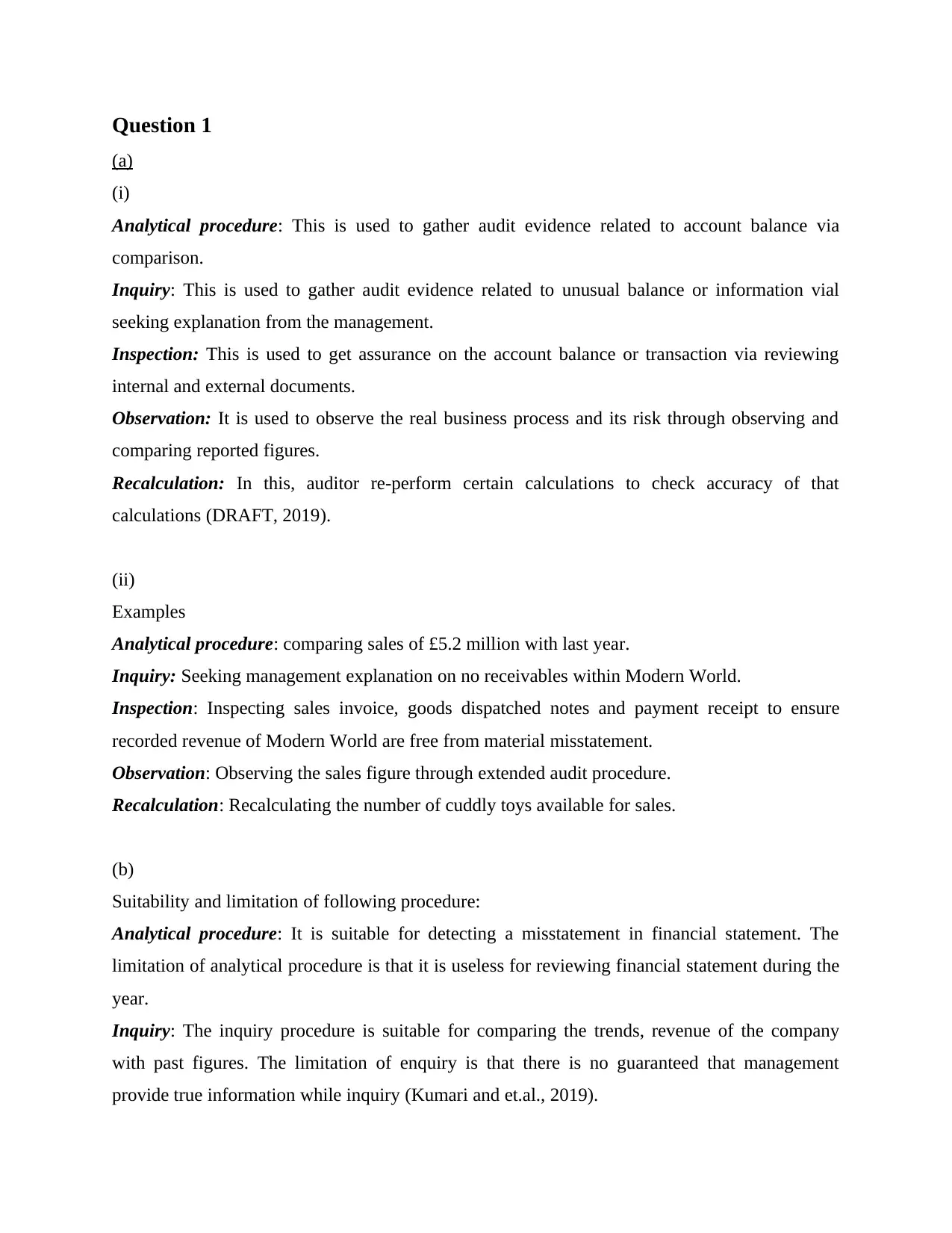
Question 1
(a)
(i)
Analytical procedure: This is used to gather audit evidence related to account balance via
comparison.
Inquiry: This is used to gather audit evidence related to unusual balance or information vial
seeking explanation from the management.
Inspection: This is used to get assurance on the account balance or transaction via reviewing
internal and external documents.
Observation: It is used to observe the real business process and its risk through observing and
comparing reported figures.
Recalculation: In this, auditor re-perform certain calculations to check accuracy of that
calculations (DRAFT, 2019).
(ii)
Examples
Analytical procedure: comparing sales of £5.2 million with last year.
Inquiry: Seeking management explanation on no receivables within Modern World.
Inspection: Inspecting sales invoice, goods dispatched notes and payment receipt to ensure
recorded revenue of Modern World are free from material misstatement.
Observation: Observing the sales figure through extended audit procedure.
Recalculation: Recalculating the number of cuddly toys available for sales.
(b)
Suitability and limitation of following procedure:
Analytical procedure: It is suitable for detecting a misstatement in financial statement. The
limitation of analytical procedure is that it is useless for reviewing financial statement during the
year.
Inquiry: The inquiry procedure is suitable for comparing the trends, revenue of the company
with past figures. The limitation of enquiry is that there is no guaranteed that management
provide true information while inquiry (Kumari and et.al., 2019).
(a)
(i)
Analytical procedure: This is used to gather audit evidence related to account balance via
comparison.
Inquiry: This is used to gather audit evidence related to unusual balance or information vial
seeking explanation from the management.
Inspection: This is used to get assurance on the account balance or transaction via reviewing
internal and external documents.
Observation: It is used to observe the real business process and its risk through observing and
comparing reported figures.
Recalculation: In this, auditor re-perform certain calculations to check accuracy of that
calculations (DRAFT, 2019).
(ii)
Examples
Analytical procedure: comparing sales of £5.2 million with last year.
Inquiry: Seeking management explanation on no receivables within Modern World.
Inspection: Inspecting sales invoice, goods dispatched notes and payment receipt to ensure
recorded revenue of Modern World are free from material misstatement.
Observation: Observing the sales figure through extended audit procedure.
Recalculation: Recalculating the number of cuddly toys available for sales.
(b)
Suitability and limitation of following procedure:
Analytical procedure: It is suitable for detecting a misstatement in financial statement. The
limitation of analytical procedure is that it is useless for reviewing financial statement during the
year.
Inquiry: The inquiry procedure is suitable for comparing the trends, revenue of the company
with past figures. The limitation of enquiry is that there is no guaranteed that management
provide true information while inquiry (Kumari and et.al., 2019).
⊘ This is a preview!⊘
Do you want full access?
Subscribe today to unlock all pages.

Trusted by 1+ million students worldwide
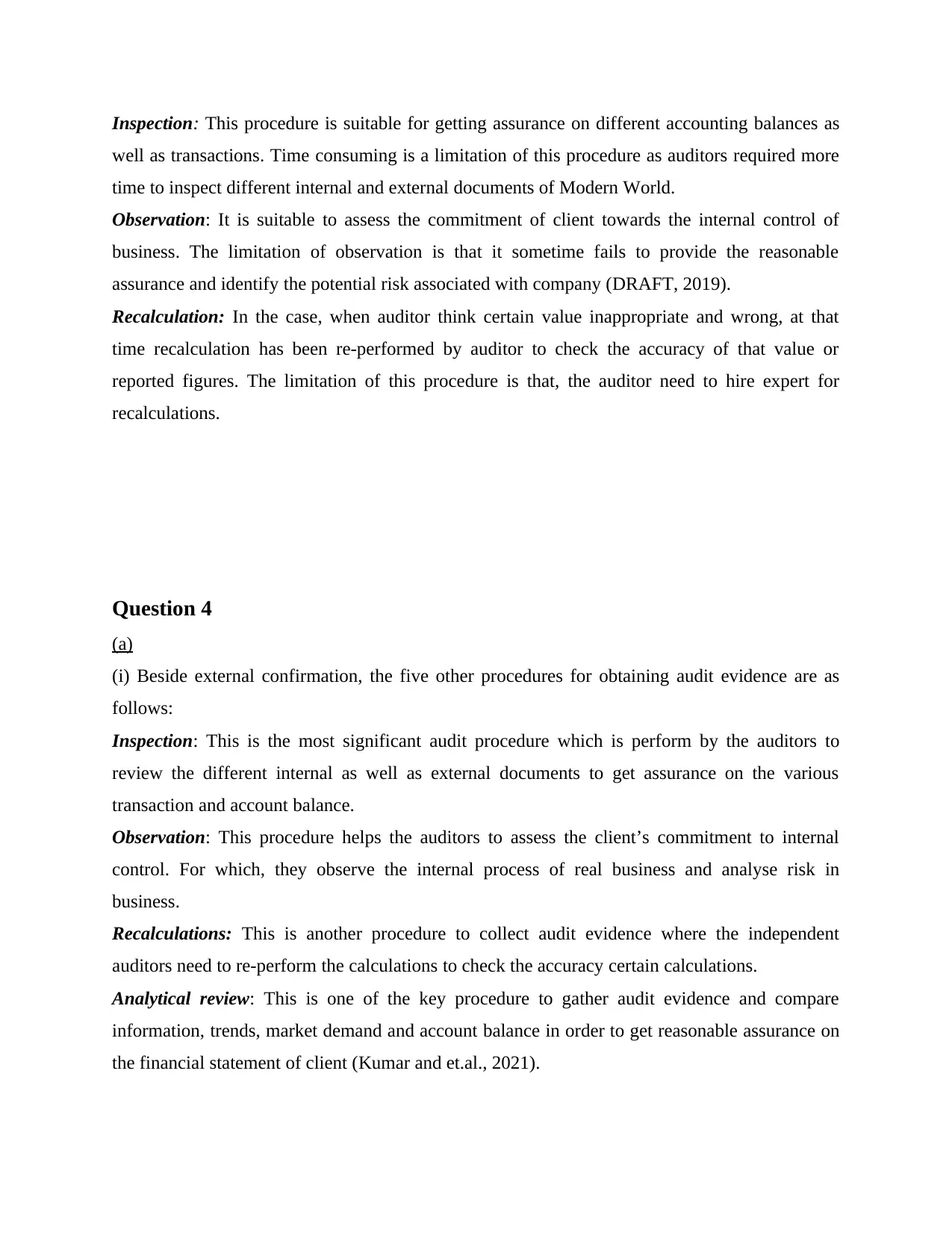
Inspection: This procedure is suitable for getting assurance on different accounting balances as
well as transactions. Time consuming is a limitation of this procedure as auditors required more
time to inspect different internal and external documents of Modern World.
Observation: It is suitable to assess the commitment of client towards the internal control of
business. The limitation of observation is that it sometime fails to provide the reasonable
assurance and identify the potential risk associated with company (DRAFT, 2019).
Recalculation: In the case, when auditor think certain value inappropriate and wrong, at that
time recalculation has been re-performed by auditor to check the accuracy of that value or
reported figures. The limitation of this procedure is that, the auditor need to hire expert for
recalculations.
Question 4
(a)
(i) Beside external confirmation, the five other procedures for obtaining audit evidence are as
follows:
Inspection: This is the most significant audit procedure which is perform by the auditors to
review the different internal as well as external documents to get assurance on the various
transaction and account balance.
Observation: This procedure helps the auditors to assess the client’s commitment to internal
control. For which, they observe the internal process of real business and analyse risk in
business.
Recalculations: This is another procedure to collect audit evidence where the independent
auditors need to re-perform the calculations to check the accuracy certain calculations.
Analytical review: This is one of the key procedure to gather audit evidence and compare
information, trends, market demand and account balance in order to get reasonable assurance on
the financial statement of client (Kumar and et.al., 2021).
well as transactions. Time consuming is a limitation of this procedure as auditors required more
time to inspect different internal and external documents of Modern World.
Observation: It is suitable to assess the commitment of client towards the internal control of
business. The limitation of observation is that it sometime fails to provide the reasonable
assurance and identify the potential risk associated with company (DRAFT, 2019).
Recalculation: In the case, when auditor think certain value inappropriate and wrong, at that
time recalculation has been re-performed by auditor to check the accuracy of that value or
reported figures. The limitation of this procedure is that, the auditor need to hire expert for
recalculations.
Question 4
(a)
(i) Beside external confirmation, the five other procedures for obtaining audit evidence are as
follows:
Inspection: This is the most significant audit procedure which is perform by the auditors to
review the different internal as well as external documents to get assurance on the various
transaction and account balance.
Observation: This procedure helps the auditors to assess the client’s commitment to internal
control. For which, they observe the internal process of real business and analyse risk in
business.
Recalculations: This is another procedure to collect audit evidence where the independent
auditors need to re-perform the calculations to check the accuracy certain calculations.
Analytical review: This is one of the key procedure to gather audit evidence and compare
information, trends, market demand and account balance in order to get reasonable assurance on
the financial statement of client (Kumar and et.al., 2021).
Paraphrase This Document
Need a fresh take? Get an instant paraphrase of this document with our AI Paraphraser
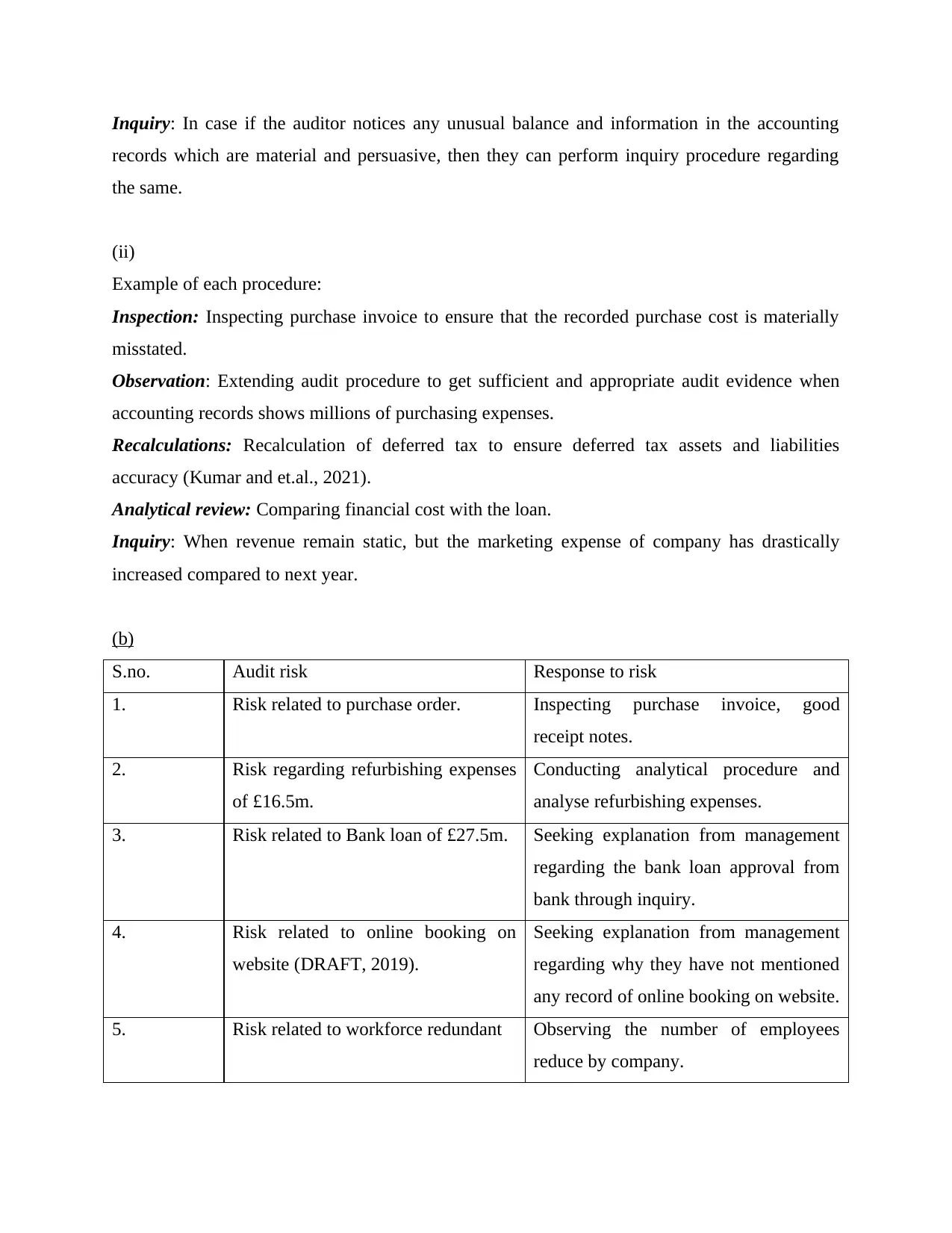
Inquiry: In case if the auditor notices any unusual balance and information in the accounting
records which are material and persuasive, then they can perform inquiry procedure regarding
the same.
(ii)
Example of each procedure:
Inspection: Inspecting purchase invoice to ensure that the recorded purchase cost is materially
misstated.
Observation: Extending audit procedure to get sufficient and appropriate audit evidence when
accounting records shows millions of purchasing expenses.
Recalculations: Recalculation of deferred tax to ensure deferred tax assets and liabilities
accuracy (Kumar and et.al., 2021).
Analytical review: Comparing financial cost with the loan.
Inquiry: When revenue remain static, but the marketing expense of company has drastically
increased compared to next year.
(b)
S.no. Audit risk Response to risk
1. Risk related to purchase order. Inspecting purchase invoice, good
receipt notes.
2. Risk regarding refurbishing expenses
of £16.5m.
Conducting analytical procedure and
analyse refurbishing expenses.
3. Risk related to Bank loan of £27.5m. Seeking explanation from management
regarding the bank loan approval from
bank through inquiry.
4. Risk related to online booking on
website (DRAFT, 2019).
Seeking explanation from management
regarding why they have not mentioned
any record of online booking on website.
5. Risk related to workforce redundant Observing the number of employees
reduce by company.
records which are material and persuasive, then they can perform inquiry procedure regarding
the same.
(ii)
Example of each procedure:
Inspection: Inspecting purchase invoice to ensure that the recorded purchase cost is materially
misstated.
Observation: Extending audit procedure to get sufficient and appropriate audit evidence when
accounting records shows millions of purchasing expenses.
Recalculations: Recalculation of deferred tax to ensure deferred tax assets and liabilities
accuracy (Kumar and et.al., 2021).
Analytical review: Comparing financial cost with the loan.
Inquiry: When revenue remain static, but the marketing expense of company has drastically
increased compared to next year.
(b)
S.no. Audit risk Response to risk
1. Risk related to purchase order. Inspecting purchase invoice, good
receipt notes.
2. Risk regarding refurbishing expenses
of £16.5m.
Conducting analytical procedure and
analyse refurbishing expenses.
3. Risk related to Bank loan of £27.5m. Seeking explanation from management
regarding the bank loan approval from
bank through inquiry.
4. Risk related to online booking on
website (DRAFT, 2019).
Seeking explanation from management
regarding why they have not mentioned
any record of online booking on website.
5. Risk related to workforce redundant Observing the number of employees
reduce by company.
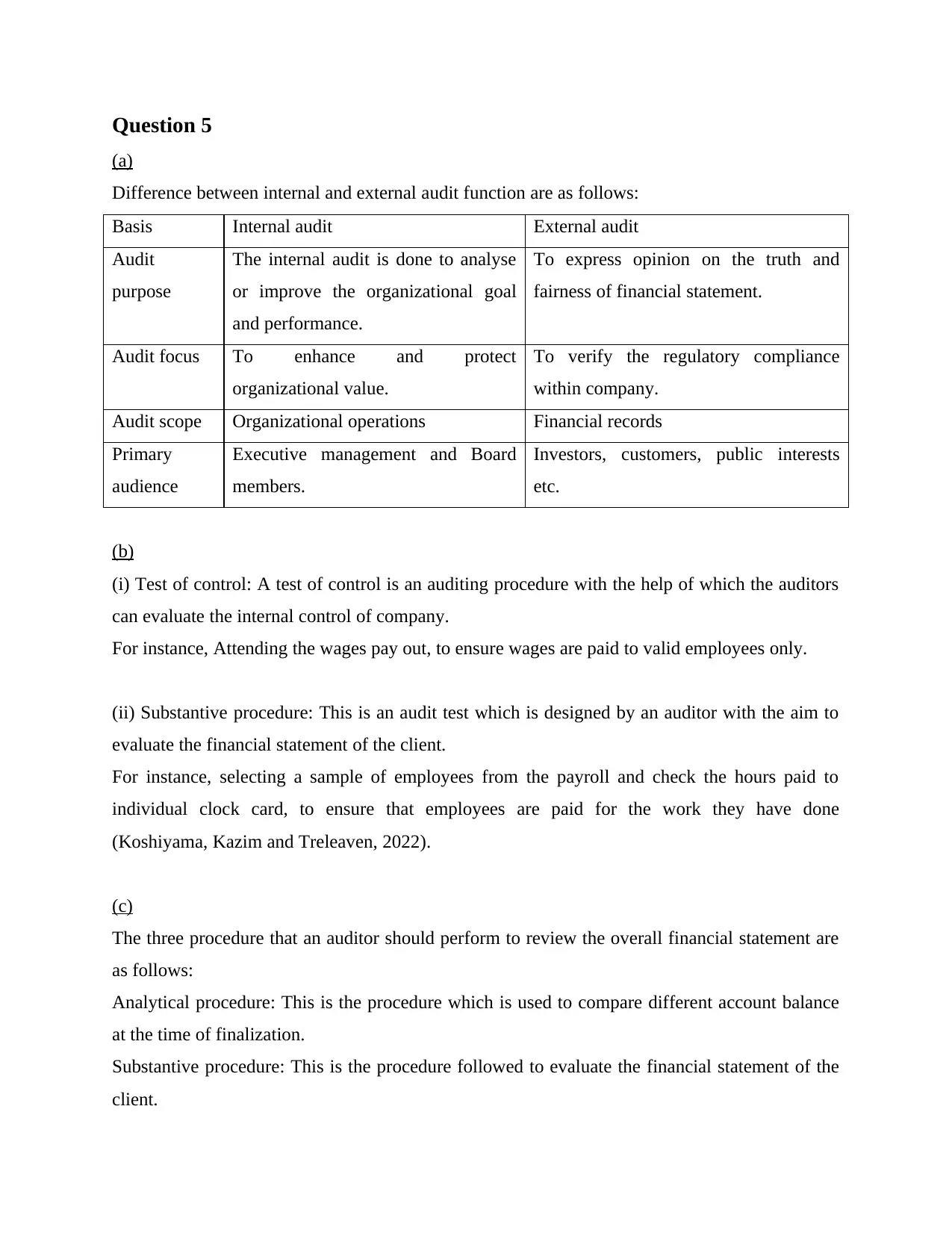
Question 5
(a)
Difference between internal and external audit function are as follows:
Basis Internal audit External audit
Audit
purpose
The internal audit is done to analyse
or improve the organizational goal
and performance.
To express opinion on the truth and
fairness of financial statement.
Audit focus To enhance and protect
organizational value.
To verify the regulatory compliance
within company.
Audit scope Organizational operations Financial records
Primary
audience
Executive management and Board
members.
Investors, customers, public interests
etc.
(b)
(i) Test of control: A test of control is an auditing procedure with the help of which the auditors
can evaluate the internal control of company.
For instance, Attending the wages pay out, to ensure wages are paid to valid employees only.
(ii) Substantive procedure: This is an audit test which is designed by an auditor with the aim to
evaluate the financial statement of the client.
For instance, selecting a sample of employees from the payroll and check the hours paid to
individual clock card, to ensure that employees are paid for the work they have done
(Koshiyama, Kazim and Treleaven, 2022).
(c)
The three procedure that an auditor should perform to review the overall financial statement are
as follows:
Analytical procedure: This is the procedure which is used to compare different account balance
at the time of finalization.
Substantive procedure: This is the procedure followed to evaluate the financial statement of the
client.
(a)
Difference between internal and external audit function are as follows:
Basis Internal audit External audit
Audit
purpose
The internal audit is done to analyse
or improve the organizational goal
and performance.
To express opinion on the truth and
fairness of financial statement.
Audit focus To enhance and protect
organizational value.
To verify the regulatory compliance
within company.
Audit scope Organizational operations Financial records
Primary
audience
Executive management and Board
members.
Investors, customers, public interests
etc.
(b)
(i) Test of control: A test of control is an auditing procedure with the help of which the auditors
can evaluate the internal control of company.
For instance, Attending the wages pay out, to ensure wages are paid to valid employees only.
(ii) Substantive procedure: This is an audit test which is designed by an auditor with the aim to
evaluate the financial statement of the client.
For instance, selecting a sample of employees from the payroll and check the hours paid to
individual clock card, to ensure that employees are paid for the work they have done
(Koshiyama, Kazim and Treleaven, 2022).
(c)
The three procedure that an auditor should perform to review the overall financial statement are
as follows:
Analytical procedure: This is the procedure which is used to compare different account balance
at the time of finalization.
Substantive procedure: This is the procedure followed to evaluate the financial statement of the
client.
⊘ This is a preview!⊘
Do you want full access?
Subscribe today to unlock all pages.

Trusted by 1+ million students worldwide
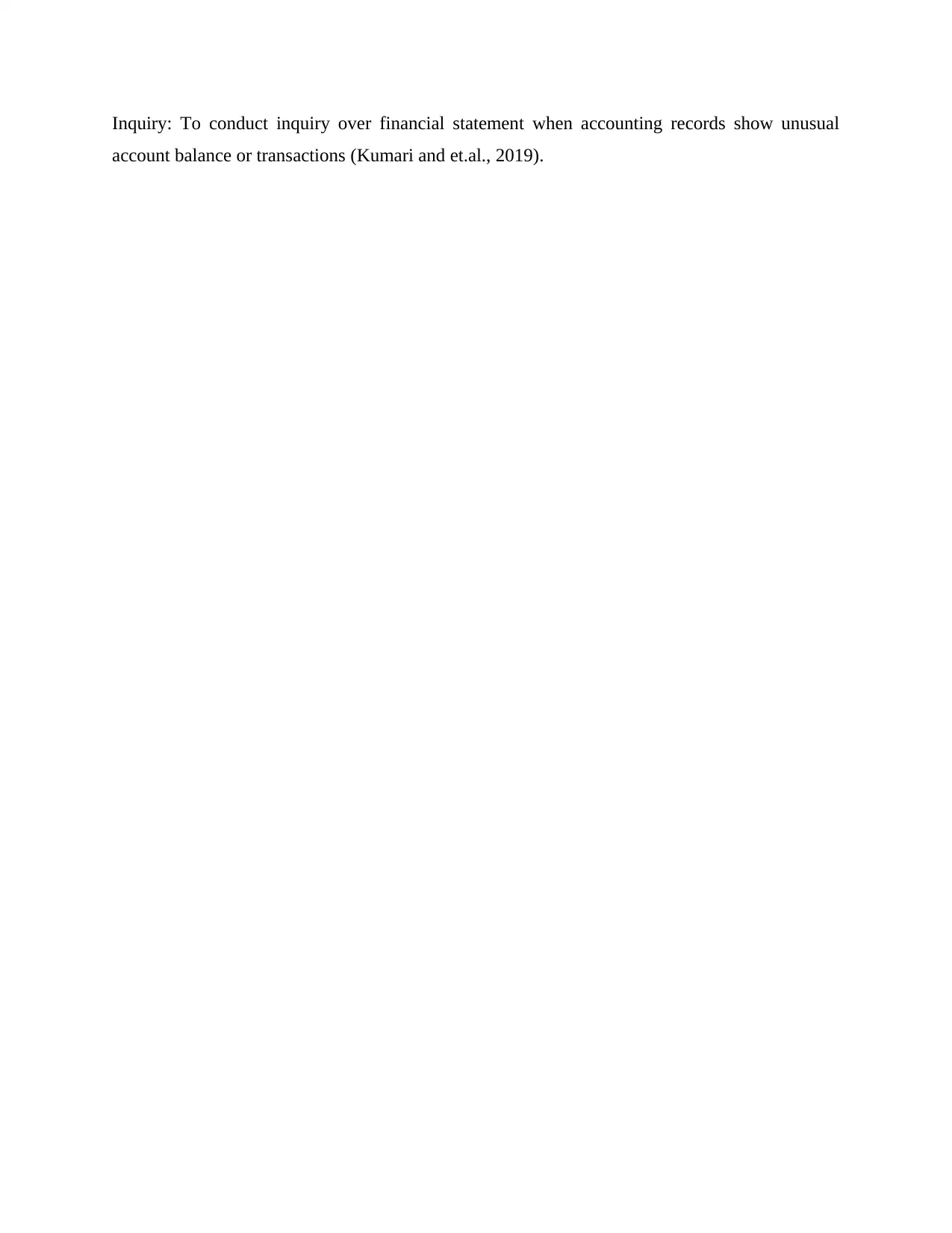
Inquiry: To conduct inquiry over financial statement when accounting records show unusual
account balance or transactions (Kumari and et.al., 2019).
account balance or transactions (Kumari and et.al., 2019).
Paraphrase This Document
Need a fresh take? Get an instant paraphrase of this document with our AI Paraphraser
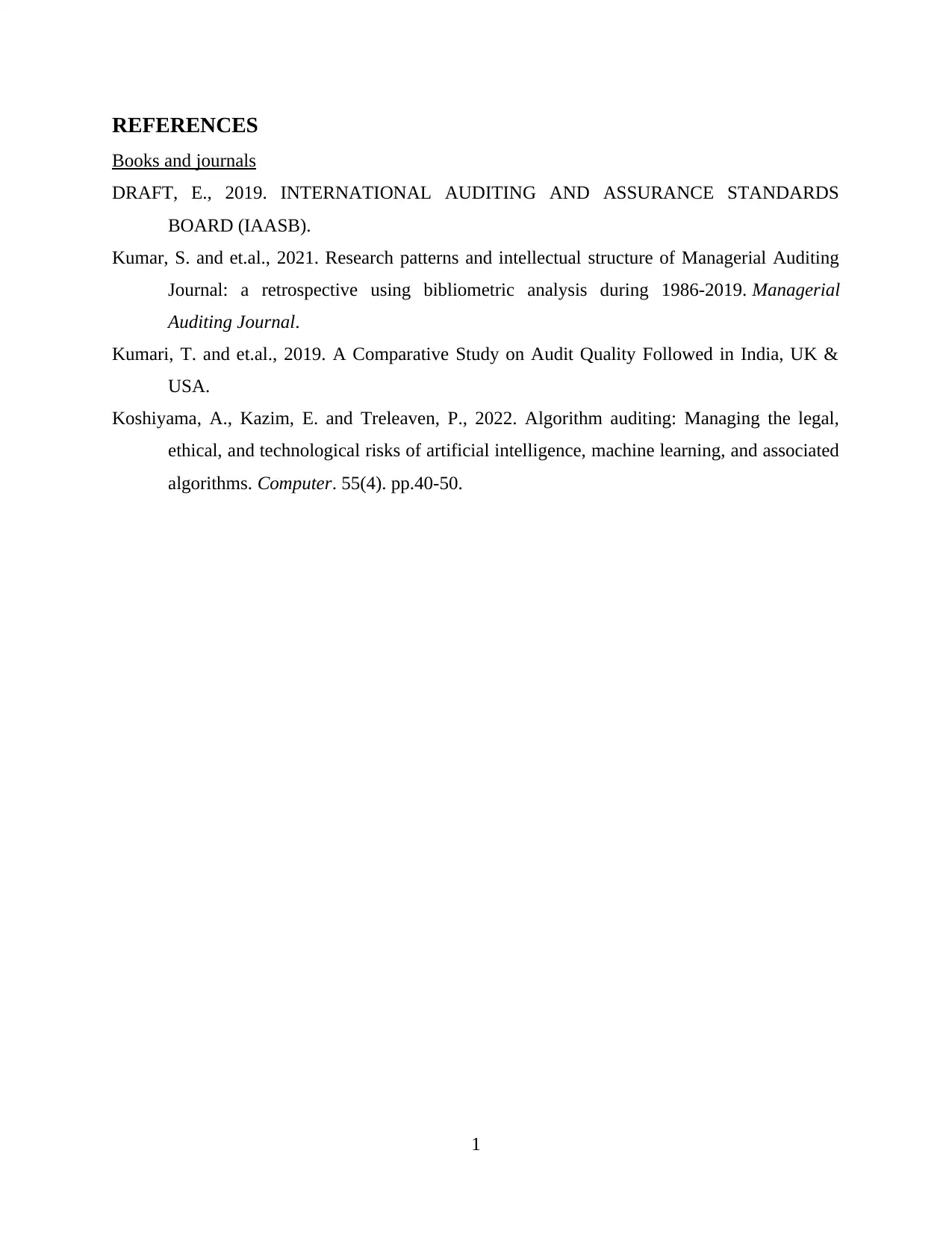
REFERENCES
Books and journals
DRAFT, E., 2019. INTERNATIONAL AUDITING AND ASSURANCE STANDARDS
BOARD (IAASB).
Kumar, S. and et.al., 2021. Research patterns and intellectual structure of Managerial Auditing
Journal: a retrospective using bibliometric analysis during 1986-2019. Managerial
Auditing Journal.
Kumari, T. and et.al., 2019. A Comparative Study on Audit Quality Followed in India, UK &
USA.
Koshiyama, A., Kazim, E. and Treleaven, P., 2022. Algorithm auditing: Managing the legal,
ethical, and technological risks of artificial intelligence, machine learning, and associated
algorithms. Computer. 55(4). pp.40-50.
1
Books and journals
DRAFT, E., 2019. INTERNATIONAL AUDITING AND ASSURANCE STANDARDS
BOARD (IAASB).
Kumar, S. and et.al., 2021. Research patterns and intellectual structure of Managerial Auditing
Journal: a retrospective using bibliometric analysis during 1986-2019. Managerial
Auditing Journal.
Kumari, T. and et.al., 2019. A Comparative Study on Audit Quality Followed in India, UK &
USA.
Koshiyama, A., Kazim, E. and Treleaven, P., 2022. Algorithm auditing: Managing the legal,
ethical, and technological risks of artificial intelligence, machine learning, and associated
algorithms. Computer. 55(4). pp.40-50.
1
1 out of 8
Related Documents
Your All-in-One AI-Powered Toolkit for Academic Success.
+13062052269
info@desklib.com
Available 24*7 on WhatsApp / Email
![[object Object]](/_next/static/media/star-bottom.7253800d.svg)
Unlock your academic potential
Copyright © 2020–2025 A2Z Services. All Rights Reserved. Developed and managed by ZUCOL.




